While living with COVID-19 is starting to become the new normal, the healthcare industry is embracing various technological trends that are better equipped to solve different challenges. One of the most recent and promising innovations that has seen a high acceptance across the healthcare industry is Telemedicine. All set to change the future of healthcare, telemedicine offers both patients and doctors the flexibility to interact in a digital environment without having the need to travel to a healthcare facility. In the wake of the pandemic, online healthcare is becoming increasingly important and people are beginning to sway more towards such online services. Gone are the days of visiting a doctor’s clinic for a minor cold or fever. Individuals are beginning to consult with a doctor online through telemedicine software, where they can get a solution within a few minutes. According to a survey by KPMG, which articulates the rising need to adapt to the trend and choose the best telemedicine software, 31% of healthcare organizations use video-based telemedicine services and 34% offer remote patient monitoring.

Advertisements such as these have become common where healthcare institutions are pushing for virtual appointments. If you are a healthcare service provider, this is the right time to jump on the bandwagon and start connecting with your patients online. But before you get started, it is imperative for you to understand what a Telemedicine software is and why would you need one in the first place.
What is a Telemedicine software?
A telemedicine software helps healthcare providers connect with patients virtually to diagnose, analyze, and provide essential treatment services. Telemedicine software platforms are used specifically to provide clinical care in a digital environment. Best telemedicine software platforms are focused on providing healthcare services remotely. A telehealth platform on the other hand has a holistic view, enhancing health care in general. Best Telemedicine software solutions can help doctors and physicians to connect with their patients via live video chats, resolve their queries, diagnose their ailments and consult accordingly.
What are the key features of Best Telemedicine software?
There are a host of features that healthcare providers must consider while choosing the best telemedicine software. Here is a list of the key features:
- Online appointment calendar
- Live audio and video conferencing
- HIPAA Compliant
- Secure document sharing and viewing
- E-Prescription
- Integrations with other medical software like EHR and Billing
- Patient and Doctor management dashboard
- Reporting and analytics
- Tech support
To help you find the best Telemedicine software, we explored and analyzed different options that are available. Here is a list of the 10 best Telemedicine software tools that are globally used based on their usability, capabilities and features.
List of the 10 Best Telemedicine Software of the Year by Software Unplugged
1. Target Health
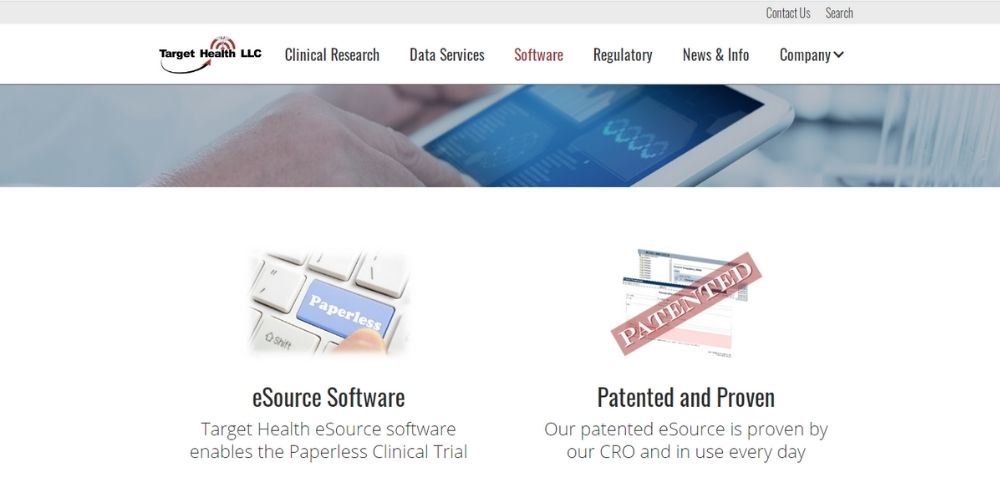
Target Health is a telemedicine software that can be used by healthcare organizations of all sizes. Their patented eSource EDC software doesn’t restrict itself to electronic data capture and data entry, but also includes a clinical trial management system, ePRO (patient reported outcomes) among other aspects making Target Health one of the best software for one’s EDC needs.
Target Health hosts a slew of features that include the likes of:
- 21 CFR Part 11 compliance
- Electronic data capture
- Patient database
- Document management
- Enrollment management
- Study planning
Reviews Unplugged
Pros:
- The patented eSource EDC software is easy-to-use and user friendly
- Introduction overview is very helpful
- Numerous features that reduces human intervention
- Accurate and efficient offering significant savings
Cons:
- Needs an ad-hoc reporting or data interrogation
- There is a learning curve to understand the software
- eCRF can have a better interface
Pricing:
Target Health does not provide a free trial. The pricing plans for Target Health are not publicly available. One can visit them at https://www.targethealth.com/ and contact them for pricing on their plans.
2. Chiron Health

Chiron Health is one of the most recommended top telemedicine software providers. It allows healthcare professionals to connect with patients for routine health appointments over secure video visits and receive full reimbursement through private payers. It is designed for healthcare practices of all sizes. It allows practitioners to increase revenue, improve patient experience and practice efficiency by transforming the way healthcare functions. It converts unpaid phone calls into billable video visits. Video visits provide the opportunity to make high-quality care accessible to patients without the hassle of a physical visit, from routine follow-ups to minor urgent care.
Key Features:
Here are a few key features of Chiron Health’s telemedicine software:
- Secure and HIPAA compliant
- Video conferencing
- Automated patient insurance eligibility check
- Appointment reminder management
- Guaranteed reimbursement – For private payer telemedicine video visits
- Appointment scheduling management
- Patient workflow management
- Integrates with multiple practice management systems like billing and reimbursement tools
- Multi-Provider Practice
- Allows EHR/PM Sync
Reviews Unplugged
Pros:
- Ease of use for patients, clinical staff, and providers
- Reliable audio and video quality
- Integrates with Athena for scheduling and collecting copays
- Great user experience
- The help desk is readily available to try to solve technical issues
Cons:
- Coverage for non-commercial insurance is not guaranteed
- Relies heavily on internet connectivity
- E-Prescribing is not available
- One-to-One Messaging is not available
- Remote Treatment Plans are unavailable
Pricing:
Chiron Health does not offer a free trial, and their pricing plans start at $150 per month, per provider.
3. Mend
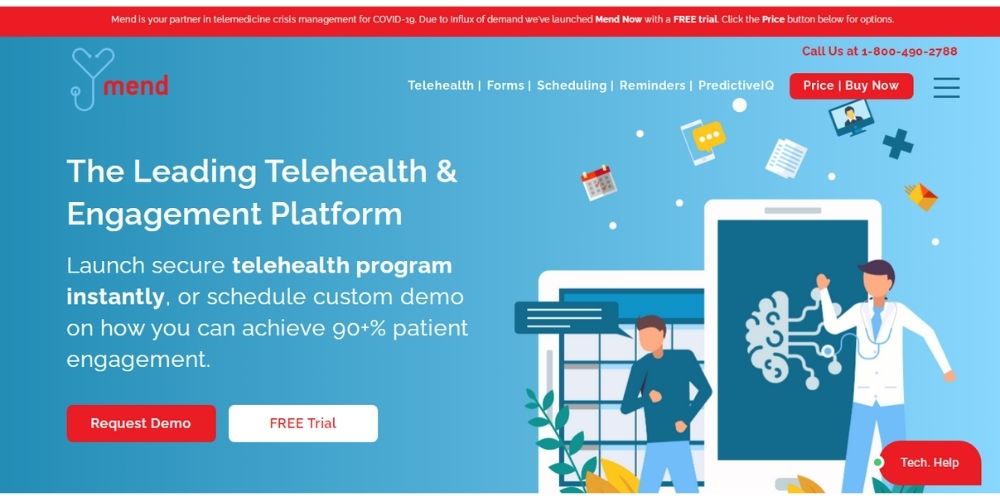
Mend is a leading telemedicine and engagement platform that provides a unique front-end solution for patient engagement. It is one of the best telemedicine software platforms available in the market that helps healthcare professionals automate the task of patient scheduling and management. It is a HIPAA compliant telemedicine platform, that provides patient appointment scheduling, video call facility, digital patient intake form, appointment reminders and seamless EHR/PMS integrations. With Mend, everything is possible with a simple click of a link. Mend saves a lot of time for healthcare administrators and patients at the same time. It is a user-friendly telemedicine software solution that adds value to a healthcare practice in leaps and bounds.
Key Features:
Mend telemedicine software’s key features are as follows:
- HIPAA Compliant
- Appointment Reminders & Scheduling
- Historic and Real-time reporting
- Patient Engagement (Patient Education, Self-Management, Patient Portal, etc.)
- EHR/PMS Integrations
- Multi-Provider Practice
- Patient Engagement (Patient Education, Self-Management, Patient Portal, etc.)
- Video Conferencing
- Health Record Access
- Artificial Intelligence based predictions
Reviews Unplugged
Pros:
- Excellent customer support
- Cuts out the paperwork and administrative time
- It works on almost all devices – desktop, laptop, tablet, mobile and with every platform – Windows, Android, Apple, and any other device with an average Internet connection
- Provides AI prediction for missed appointments
- No software to download. Works with a link click.
Cons:
- Difficult for a first-time user to understand
- Very sensitive to internet connectivity
- No option to schedule recurring appointments
- It gets easily interrupted by incoming calls and text
- Admin User Interface is a bit complicated and intuitive
Pricing:
Mend offers a free demo, and their price plans at the moment start at $49 per provider.
4. Doxy.me

Doxy.me is a cloud-based HIPAA, GDPR, PHIPA/PIPEDA, & HITECH compliant telemedicine software solution designed to help healthcare professionals across the globe. It is one of the best telemedicine software solutions that is easily accessible. It is also an easy to use telemedicine software solution for both healthcare practitioners and patients. Doxy.me allows healthcare specialists to connect with their patients quickly, easily, and efficiently. It provides Enterprise White Label Telemedicine Platform for clinics, hospitals, health systems and even professional organizations. It lets patients and healthcare providers switch to online appointments with ease.
Key Features:
Here are a few features that Doxy.me cloud based telemedicine platform provides:
- Live Chat
- Multi-Provider Practice
- Patient Queue Management
- Waiting Room Management
- HIPAA, GDPR, PHIPA/PIPEDA, & HITECH Compliant
- Video Recording
- Activity Dashboard
- Business Associate Agreement included
- Provides Meeting History
- Enterprise White Label Telemedicine Platform
Reviews Unplugged
Pros:
- Patients do not need to download any application – No username, no password are required. The application works with the click of a link.
- Not only HIPAA compliant but also secure.
- Allows people to wait in a virtual ‘waiting room’ until the healthcare professional is ready.
- BAA is available in the free version too.
- Ability to support multiple staff members using the platform at the same time.
Cons:
- Freezes up during a session when connectivity is not very strong.
- Not recommended for group online therapy.
- The free version doesn’t have provide access to direct customer support.
- Online scheduling with a waiting list option that will inform clients on the waiting list is unavailable.
- Occasional sound distortions.
Pricing:
Doxy.me offers a free trial, with its plans starting at $29 per month, per user.
5. Teladoc
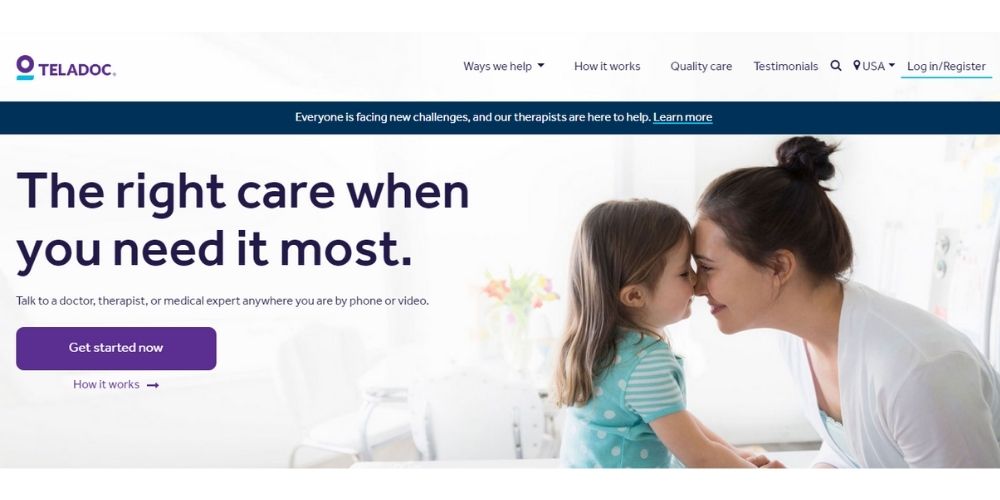
Teladoc is a cloud-based telemedicine software solution for healthcare systems and hospitals. The platform ensures patients can connect with doctors virtually through web, phone or through the app. Customizable and configured to one’s needs, Teladoc also offers bidirectional exchange to integrate with a health system’s existing electronic health records. This Best Telemedicine Software platform also uniquely offers healthcare systems marketing support aiding them in advertising their offerings to their patients.
Key Features
Teladoc offers myriad features that include the likes of:
- Appointment reminders
- E-prescribing
- HIPAA Compliant
- Online forms
- Remote treatment plans
- Multi-provider practice
- Appointment scheduling
- Video conferencing
- One-to-one messaging
Reviews Unplugged
Pros:
- Quick response time from the support
- Ability to add pictures if needed
- Wide variety of services offered
- Multinational presence
- Connected with numerous insurance companies
Cons:
- Setting-up can be tricky
- Calls from the doctor come from an unlisted number
- Sometimes information is not stored/followed up with the login
Pricing:
Teladoc does not have a free trial, and its pricing starts at $49 as a one-time payment, per user.
6. Vsee
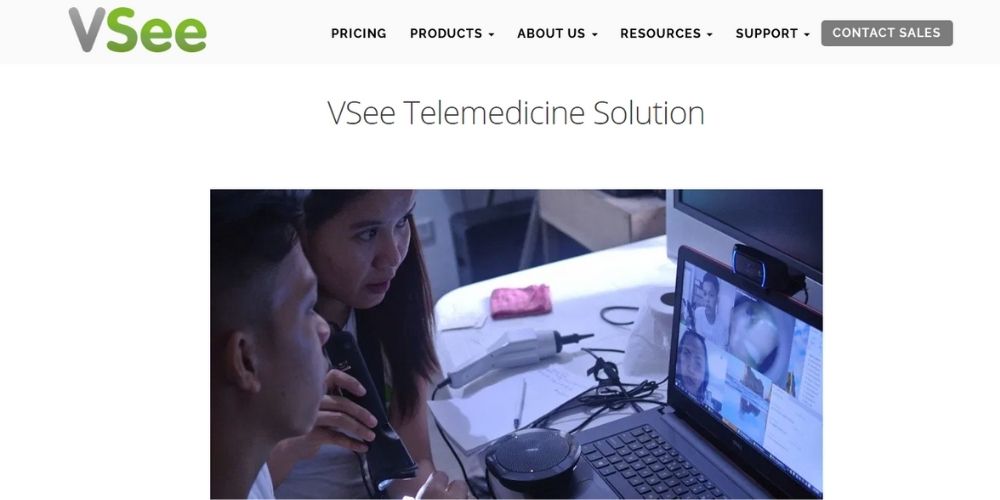
VSee helps doctors and physicians manage online consultations with their patients. Working in accordance with the HIPAA regulations, VSee helps in creating customized intake forms, helps out in scheduling appointments, along with having patients in the waiting room through website or email widgets. Available also as a mobile application for Android and iOS devices, this top telemedicine software helps clients with one-on-one video calls, live streaming of required procedures among others. The platform also allows doctors to ask for patients’ feedback along with allowing users to schedule their future visits.
Key Features
Vsee telemedicine system brings with a slew of features that include the likes of:
- Appointment reminders
- E-Prescribing
- Multi-provider practice
- Appointment scheduling
- One-to-one messaging
- Practice management
- Video conferencing
Reviews Unplugged
Pros:
- Simple and straightforward interface
- Works across multiple platforms
- Reliable across different bandwidths
- Completely encrypted and secure
- Option of sharing full screen or just individual windows
Cons:
- The app must continue to run in the background to receive any message
- Customer support is not very easy to reach out to
- Healthcare professionals could receive a video call anytime as long as they’re online
Pricing:
VSee does not offer a free trial and its plans start at $49 per month, per user.
7. eVisit
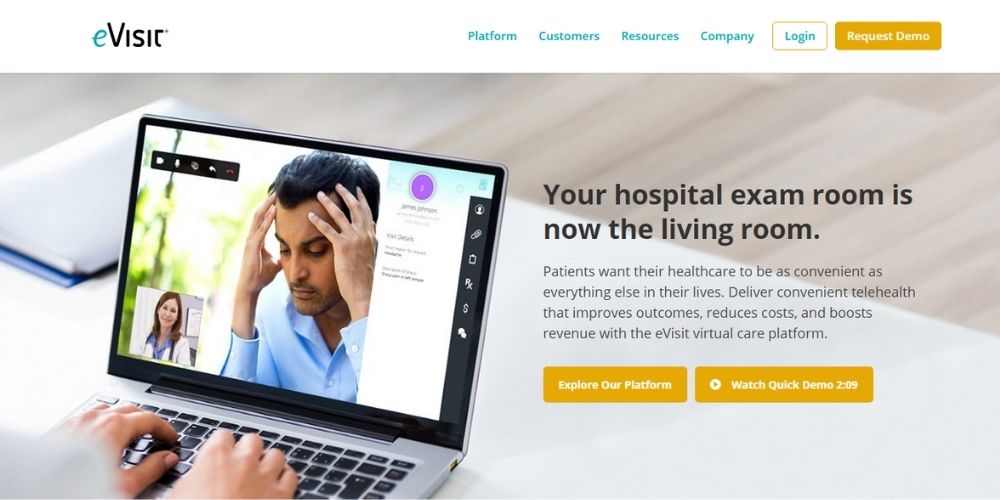
eVisit is a cloud-based telemedicine software that is HIPAA compliant. Designed for small and midsize healthcare practices, eVisit caters to primary care, mental health clinics, pediatric, surgery, pain management among others. The software also allows users to track loyalty and revenue. Compatible with Windows, Linux and Mac OS, this best telemedicine software offers support across text, phone and email. The telemedicine platform also comes as a mobile application for both iOS and Android.
Key Features
eVisit has numerous features that include:
- Medical charting
- Data collection
- Reimbursement management
- Patient scheduling
- Mobile consultation
- Screenshare options
- E-Prescription
- Insurance information records
Reviews Unplugged
Pros:
- Great and effective customer support
- Multiple online payment options
- Real time charting
- User friendly interface that does not require a lot of maintenance
Cons:
- No password protection
- Connectivity issues result in a lot of call drops
- The EHR is not up-to the mark
Pricing:
eVisit does not have a free trial, and its pricing starts at $600 per month.
8. ReDoc
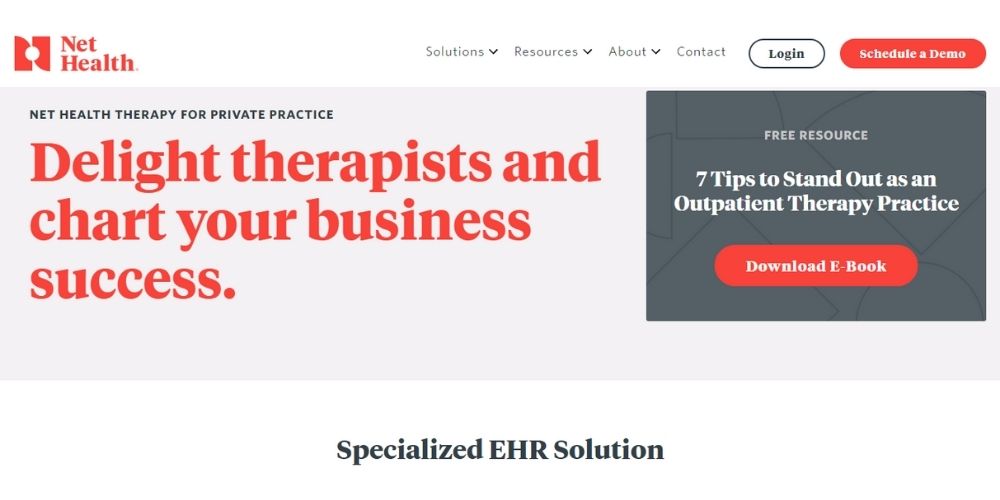
ReDoc is a cloud-based telemedicine solution that manages scheduling, practice management, therapy documentation among other aspects. The workflow practices ensure compliance, boosting efficiency and helping with tools that increase revenue. It is also integrated with tools like fax management, appointment reminders, home exercise program and others. With billing and workflow optimization management, ReDoc is one of the best telemedicine software(s) in the market.
Key Features
ReDoc telemedicine software hosts numerous features including:
- Appointment management
- Assessments
- EHR/EMR
- Insurance management
- Progress notes
- Treatment plans
- Billing & Invoicing
- Practice management
- Multi-location
Reviews Unplugged
Pros:
- Quick turn-around for updates and fixes
- Competitive pricing
- Easy-to-use interface
- Billing is easy to execute
Cons:
- Customer support is erratic
- Documentation for evaluation and re-evaluation is unclear
- Needs a little work on the interface
Pricing:
ReDoc does not offer a free trial, and its pricing plans are available only upon request.
9. American Well

A cloud-based telemedicine management solution, American Well is designed for healthcare practices of all sizes. Along with the customary features that include the likes of doctor scheduling, access to medical history among others, American Well offers pre and post visit post, photo viewing and a virtual waiting room. This best telemedicine software also has an Ask-Me module that allows patients to connect with doctors without an appointment. With support being offered through phone, email and online, the software also offers support for reimbursement and claims.
Key Features
American Well’s range of features include:
- 24/7/365 clinician coverage and training
- Business intelligence and analytics
- 24/7/365 end user and device support
- Grant support
- Implementation Services
- HIPAA compliant patient marketing
Reviews Unplugged
Pros:
- Easy to set-up at any location
- Simple interface with a built-in translation
- Ability to connect with different facets
Cons:
- Erratic connectivity
- Poor sound quality
Pricing:
American Well does not offer a free trial. Its pricing plans are available only upon request. Visit https://business.amwell.com/ to find out more.
10. OnCall Health Platform
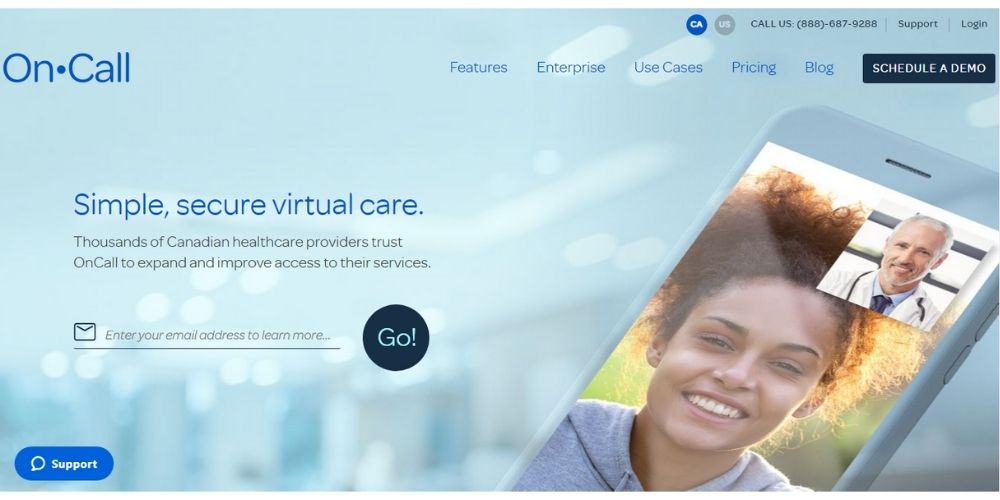
OnCall Health is PIPEDA and HIPAA compliant solution for healthcare institutions. The solution offers instant video and messaging appointments. With a dedicated support, analytics features and key tracking metrics, this best telemedicine software’s cloud-based capabilities makes it accessible across any computer.
Key Features
The key features of OnCall Health telemedicine platform include:
- HIPAA and PIPEDA compliant
- One-on-one or group video appointments
- Encounter-based instant messaging
- Patient roster
- Digital custom intake forms
- Automatic billing
- Appointment reminders
- Provider-led or patient-led appointment booking
- Digital notes storage
Reviews Unplugged
Pros:
- Easy, simple and straightforward interface
- One of the most reliable telemedicine software solutions
- Great for managing administrative duties by setting appointment reminders
Cons:
- No option to print digitized documents
- No convenient way to pull out the notes without searching individually
Pricing:
OnCall Health gives out a free demo. Their pricing plans start at $49 per month for the base subscription.
Frequently Asked Questions about Telemedicine Software
What is the difference between Telehealth and Telemedicine?
In today’s technology-driven age, numerous medical tech terms are being used that not everyone is familiar with. Telehealth and telemedicine are two such words that are commonly used but are hardly distinguishable for the layman. So, let us address the telehealth vs telemedicine debate by looking at each of these terms individually.
Telehealth is a term that is used in the broad sense, where it serves as an all-encompassing term in the medical technology stream. It includes the likes of remote monitoring, ECG, blood pressure, health education services, and remote doctor consultations. To understand telehealth vs telemedicine, one has to understand that telehealth is the technology that enables the remote evaluation of the patient, remote diagnoses, remote detection of the patient’s condition, and fluctuations in their condition. It also comprises of the system that allows e-prescriptions and helps in delivering the prescribed treatments remotely.
Telemedicine on the other hand is a narrower subject. In the telehealth vs telemedicine debate, telemedicine can be defined as the stream that caters to delivering education over a distance and making sure that the provision of health care services is delivered with the use of telecommunications. It also refers to the use of different information and electronic technologies that are used to provide clinical services remotely to patients. To understand telehealth vs telemedicine, one can also look at telemedicine as the system that allows digital transmission of medical imaging, video consultations with specialists, remote evaluations, and diagnosis.
What are the benefits of Telemedicine Software for Providers?
Today’s world runs on convenience and access to instantaneous information. This has seeped into the healthcare industry too, where patients are leaning towards tech-driven solutions that help them stay connected with their medical practitioners. Telemedicine software for providers has a plethora of benefits that include the likes of:
Extensive access to care
There is a perpetual shortage of medical healthcare providers. Getting an appointment with a healthcare provider is often a challenge for patients. Telemedicine software for providers helps them in having medical call centers and advice lines, thereby offering expansive and extensive care to the ones in need.
Reduce readmissions
More than often healthcare institutions are overwhelmed with readmissions from those with chronic illnesses. With telemedicine software for providers, healthcare institutions can ensure physicians stay connected with their patients, without them being readmitted. It also helps them spot early signs of any problem, helping them treat it before it becomes dangerous.
Smoother workflow
Telemedicine software for providers helps them in identifying a patient’s cause of concern, helping them prioritize care, ensuring the treatment is streamlined well before the patient enters the hospital. Along with streamlining the workflow, a telemedicine software for providers also helps them with designating roles that ensure no member of the staff is ever overwhelmed with additional duties.
What are the core components of a telemedicine software?
Telemedicine software solutions are bound to be used extensively, owing to their effectiveness and efficiency. While healthcare institutions are expected to check different telemedicine software solutions and choose the one that fits their requirements, every telemedicine software solution is bound to have a few components that are at the core of its functioning.
All telemedicine software solutions must include:
Collaborative tools that enable the hospital staff to connect with different parties seamlessly. These include patients, vendors, suppliers, staff, visiting staff. All of them through multiple mediums that include smartphones, laptops, and tablets.
Medical peripherals like ultrasound machines, digital stethoscopes, and otoscopes need to easily collaborate with other tools in telemedicine software solutions. This helps in offering critical support through access to multiple devices.
Workflow management is one of the core components of all telemedicine software solutions. They must offer secure messaging, billing mechanisms, easy-connect to EHRs to ensure the work is streamlined.
Cloud-based services and solutions define the longevity of telemedicine software solutions. It is what makes it feasible even for smaller providers to adopt telemedicine software solutions, ensuring that they don’t lose out to the competition.
What is the cost of telemedicine software?
The cost of telemedicine software is one of the crucial aspects for consideration. It is important to note that there is no one size fits all solution when it comes to setting up a telemedicine software or even for defining the cost of telemedicine software. The cost of telemedicine software is directly proportional to the staff that a healthcare institution has and the number of patients they anticipate serving.
It also depends on the computer systems that are already in place, the IT infrastructure that an institution has, or the one they wish to expand to. The number of portable devices in operation, their bandwidth, the required training that is to be offered to the staff, and deployment of necessary security features all play a major role in defining the cost of telemedicine software that is being adopted.
What are the different types of Telemedicine softwares?
Telemedicine software helps in the delivery of clinical services remotely. There are three different types of telemedicine software(s). These are store and forward, remote patient monitoring, and real-time encounter. Let us look at each one in detail:
Remote patient monitoring
Remote patient monitoring is one of the most common types of telemedicine software. It helps healthcare providers track patients’ health remotely with the help of different medical devices. This type of telemedicine software is common among physicians who want to check-in on their patients regularly.
Store and forward telemedicine
Store and forward is another type of telemedicine software that is used extensively around the world. It uses a health history that is earlier recorded to be showcased through different electronic communication solutions. Used widely across rural areas, the store and forward type of telemedicine software can help medical specialists reach places that aren’t accessible.
Real-time telemedicine
The real-time telemedicine software is among the most widely used types of telemedicine software in the world. It requires the healthcare provider and patient to interact in real-time through an online video conference or chatroom or call to render care and diagnosis.
How is telemedicine transforming health care?
Telemedicine software platforms are redefining healthcare around the world. They are facilitating access to doctors anytime, from anywhere, and is paving way for healthcare systems that were earlier deemed impossible. Telemedicine software platforms have bridged the ever-present gap that existed in accessing doctors. With access to doctors being limited to majoritarian populations of the world, telemedicine software platforms are aiming at filling the biggest void in the field of healthcare.
Another facet that different telemedicine software platforms are helping is in reducing the exorbitant costs that have plagued the healthcare industry since time immemorial. Healthcare costs have often resulted in a social divide, where accessibility and effectiveness, both have taken a hit for the worse. With the right telemedicine software platforms, accessibility, and awareness towards healthcare can be increased.
Telemedicine software platforms can also help in effective and efficient patient monitoring. While patients were expected to visit healthcare institutions for every check-up, burdening both the patients and healthcare institutions, telemedicine software platforms are a blessing. It helps physicians monitor relevant data to offer pertinent and timely solutions.
What are the factors to consider before you implement a telemedicine solution?
Implementing software for telemedicine comes with its own set of challenges. While its role is indispensable in today’s day and age, here are a few factors that one must consider before implementing software for telemedicine:
Patient experience – While it’s the healthcare institution that is implementing the telemedicine software, the patients are the ones who use it extensively. The software for telemedicine must be user-friendly for patients and must also cater to their requirements.
Technological requirements – The software for telemedicine comes with its own set of requirements. Every healthcare institution must look at the IT and technological infrastructure that is already in place and must plan to have a solution that fits their existing infrastructure.
Implementation time – While a telemedicine software is bound to bring efficiency, institutions must also be aware of the time it would take time to integrate it extensively. Institutions must take this into consideration and are expected to plan alternative solutions to ensure no service is disrupted.
Training opportunities – A software for telemedicine is expected to bring ease and efficiency into the system. However, if a solution brings with it an arduous training regime, it defeats the entire purpose. To ensure that the entire staff is not overburdened with training modules, the selected telemedicine software must offer ease in learning and application.
How much does telehealth software cost?
While considering a telehealth software, one of the first questions that every healthcare institution thinks of ‘How much does telehealth software cost’? The fact of the matter is for a clinical setting, rolling out a telehealth offering is relatively expensive. Depending on the type of equipment that is required and the specialty of the services, a telehealth software can range anywhere from $ 10,000 for a clinical site to just a few couple hundred dollars per month per provider. Another pertinent question is if the institutions are looking for a telehealth software that would be stored in-house on-premise or on the cloud. Having a cloud-based telehealth software is considered as a much more economic option in comparison with in-house telehealth software.
What is a hipaa compliant telemedicine software platform?
Owing to the rapid development in technology, there has been a proportional development in the field of telemedicine too. It has seen rapid developments, wherein it is using various technology-led tools like video conferencing, cameras, smartphone apps, and wearable devices.
But, with such rapid development, there is also a lot of variation in the delivery mechanism of these software solutions. To ensure that every digital provider is offering enhanced digital proximity with quality care, healthcare institutions are looking for HIPAA compliant telemedicine software. Being a HIPAA telemedicine software helps institutions have a standardized set of measures that can be used across various streams, offering unparalleled patient care anywhere across the world.
What is a Telemedicine emr software?
Telemedicine EMR software is the software that helps connect caregivers with patients using telecommunication technology. The software helps clinicians, doctors, and physicians check and diagnose patients. Thanks to the development of technology, telemedicine EMR software can now provide various effective clinical services that include medication management, follow-up visits, and health consultations through video conferencing or audio modules. Thanks to its user-friendly nature, patients and doctors across the world are using Telemedicine EMR software extensively.
A telemedicine EMR software is as good as the features it offers. It is integrated with EHR or electronic health records, has real-time patient engagement, uses browser-based deployment, and has various scheduling features.
What is a telehealth video conferencing software?
Telehealth video conferencing software is shaping to be the most used aspect of telehealth software solutions in the world. For patients who cannot visit the doctor’s office due to any unforeseen circumstances, telehealth video conferencing software comes in to be useful. The telehealth video conferencing software is a flexible, purpose-built solution for healthcare that can be integrated with software endpoints, EHR, and different medical devices. It enables virtual care including the likes of pediatrics, rural ambulatory, along with high-demand specialties like cardiology, psychology, and neurology.
Patients, doctors, and healthcare institutions are all benefiting from the telehealth video conferencing software as it facilitates collaboration and enhances effective communication between different stakeholders. The software also helps in the provision of healthcare services to patients from across the world. A telehealth video conferencing software also has numerous innovative features like cube calling that allows different individuals to communicate using different protocols. It also helps in forming close networks within and outside their organizations. Doctors can also use telehealth video conferencing software to collect patient data while offering the required care right at the comfort of their home.
Can you share some popular telemedicine use cases?
The best telemedicine software always offers urgent care to patients effectively. In today’s day and age, the use cases of the best telemedicine software also include telestroke or teleradiology with other different specialties connecting patients with physicians. However, here are the four most common use cases of the best telemedicine software:
Follow up visits
Multiple visits are always a burden. Both for the patient and the provider. This leads to an increase in the readmission rate, which can lead to overwhelming the institution and monetary repercussions for the patient. Good telehealth software reduces follow-up visits with remote care that is efficient and effective.
Pre-screenings
More than often a patient is unsure of their condition before visiting the healthcare institution. Pre-screenings through a telemedicine software can help in identifying the exact reason for a patient’s visit and can determine the treatment or diagnosis that is required before they even step in.
Remote experts
More than often, healthcare experts are not easily accessible to everyone. Sometimes this demands a patient to travel a considerable amount of distance for a quick consultation. The best telehealth software ensures secure exchange of data enabling healthcare experts to offer their services anytime, ensuring convenient and accessible care.
In-home care
In some unforeseen circumstances, it might be difficult for patients to travel to a medical center. In such situations, in-home care can be offered by a telehealth software, wherein the patient can approach a doctor and be offered care, right at their homes.
Telemedicine Software Comparison
While there are a plethora of benefits of telemedicine software, medical practices have a hard time choosing the right one that meets their demands and needs. While it is tough to make a choice , you can find a comparative study between different softwares that take you through the features, which industry they are apt for, technical specifications, and much more.
Here is a detailed comparison –
Amwell vs. Teladoc
Doxy.me vs. Vsee

